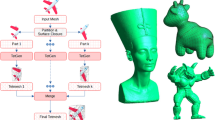Abstract
Creating and rendering intermediate geometric primitives is one of the approaches to visualize data sets in 3D space. Some algorithms have been developed to construct isosurface from uniformly distributed 3D data sets. These algorithms assume that the function value varies linearly along edges of each cell. But to irregular 3D data sets, this assumption is inapplicable. Moreover, the depth sorting of cells is more complicated for irregular data sets, which is indispensable for generating isosurface images or semitransparent isosurface images, if Z-buffer method is not adopted.
In this paper, isosurface models based on the assumption, that the function value has nonlinear distribution within a tetrahedron are proposed. The depth sorting algorithm and data structures are developed for the irregular data sets in which cells may be subdivided into tetrahedra. The implementation issues of this algorithm are discussed and experimental results are shown to illustrate potentials of this technique.
Similar content being viewed by others
References
Doi A, Koide A. An efficient method of triangulating equi-valued surface by using tetrahedral cells.IEICE Transactions, 1991,E74(1):214–224.
Wallin A. Constructing isosurfaces from CT data.IEEE CG & A. 1991, 28–33.
Giertsen C. Volume visualization of sparse irregular meshes.IEEE CG & A, 1992, 40–48.
Upson C, Keeler M. V-buffer: Visible volume rendering.Computer Graphics, 1988, 22(4): 59–64.
Speray D. Volume probes: Interactive data exploration on arbitrary grids.Computer Graphics, 1990, 24(5): 5–12.
Nielson G M, Hamann B. The asymptotic decider: Resolving the ambiguity in marching cubes. In: IEEE Visualization'91, 83–91.
Ximen J, Kapp O H. Three dimensional algebraic reconstruction from projections of multiple grey level objects.Optik, 1986, 72(3): 87–94.
Westover L. Footprint evaluation for volume rendering.Computer Graphics, 24(4): 367–376.
Durst M J. Letters: Additional reference to “Marching Cubes”.,Computer Graphics (ACM SIGGRAPH Quarterly), 1988, 22(2).
Levoy M. Display of surface from volume data.IEEE CG & A 1988 8(3): 29–37.
Chin N, Feiner S. Near Real-Time Shadow Generation Using BSP Trees.Computer Graphics, 1989, 23(3): 99–106.
Max N, Hanrahan P, Crawfis R. Area and volume coherence for efficient visualization of 3D scalar function.Computer Graphics, 1990, 24(5): 27–33.
Drebin R, Carpenter L, Hanrahan P. Volume rendering.Computer Graphics, 1988, 22(4): 65–74.
Gallagher R S, Nagtegaal J C. An efficient 3D visualization technique for finite element models and other coarse volumes.Computer Graphics, 1989, 23(3): 185–192.
Lorensen W E, Cline H E. Marching cubes: A high resolution 3D surface construction algorithm.Computer Graphics, 1987, 21(4): 658–664.
Author information
Authors and Affiliations
Additional information
This project is supported by National Natural Science Foundation of China.
Rights and permissions
About this article
Cite this article
Zhou, Y., Tang, Z. Constructing isosurfaces from 3D data sets taking account of depth sorting of polyhedra. J. of Compt. Sci. & Technol. 9, 117–127 (1994). https://doi.org/10.1007/BF02939493
Received:
Revised:
Issue Date:
DOI: https://doi.org/10.1007/BF02939493




